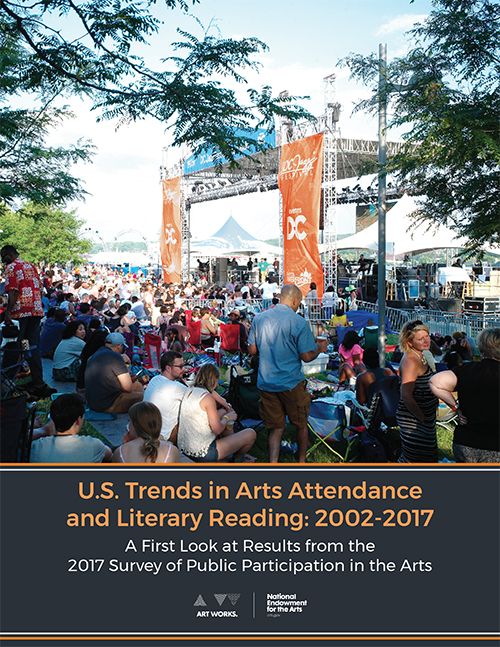New Report on Arts Attendance Shows Gains
From Victoria Hutter, Assistant Director, Press | Public Affairs, National Endowment for the Arts –
New survey findings from the National Endowment for the Arts (NEA) show gains in arts attendance totals, rates, and demographic groups plus sizeable growth in poetry-reading. Published today, U.S. Trends in Arts Attendance and Literary Reading: 2002-2017 is a first look at results from the 2017 Survey of Public Participation in the Arts (SPPA). A partnership of the NEA and the U.S. Census Bureau, the SPPA is the nation’s largest and longest-running survey of how millions of adults participate in the arts.
The gains in arts attendance in U.S. Trends in Arts Attendance and Literary Reading: 2002-2017 track with findings from a recent National Endowment for the Arts report, in partnership with the U.S. Bureau of Economic Analysis, which shows growth in consumer spending at the box office for performing arts events. The performing arts together with other arts and cultural industries contributed more than $760 billion to the nation’s economy in 2015.
The new U.S. Trends report covers shifting patterns of arts attendance and literary reading as measured by the share of Americans aged 18 years and older who reported doing any of these activities at least once in a year. The report covers the years 2002, 2008, 2012, and 2017.
“The growth in arts attendance indicates the increasing value of the arts in the everyday lives of Americans,” said Acting Chairman Mary Anne Carter. “From poetry reading to visiting a museum or attending a jazz performance, the arts are not only part of our lives, but also assets in our communities and fuel for our nation’s economy.”
The 2017 SPPA findings for arts attendance are positive in comparison to the 2012 results.
Between 2012 and 2017, the share of adults who attended visual or performing arts activities grew by 3.6 percentage points to 132.3 million people, representing nearly 54 percent of the U.S. adult population. Performing arts events range from dance to theater performances while visual arts events include going to art museums, galleries, and craft festivals.
Most of the increase in this survey came from visiting art museums or galleries and the “informal” arts sector that includes outdoor performing arts festivals and touring places for their design or historic value. Also scoring high is attending “other” performing arts events—those not tracked individually in the SPPA—such as rap and hip hop, country music, rock, or folk music events.
An area of substantial growth in the 2017 findings is reading poetry.
Between 2012 and 2017, the rate of poetry-reading among adults grew by 76 percent, to 28 million people in 2017. Other significant findings include:
- The share of 18-24-year-olds who read poetry more than doubled
- Women showed notable gains, increasing from 8 percent in 2012 to 14.5 percent in 2017
- Hispanic poetry readers increased from 4.9 percent in 2012 to 9.7 percent in 2017
- Other racial and ethnic subgroups saw gains such as African Americans (+8.4 percentage points) and Asian Americans (+7.8 percentage points) between 2012 and 2017.
In addition, reading plays has increased, but reading novels and short stories continued on a pattern of decline.
Further on the performing arts, 106.8 million people attended in 2017, up 3.2 percentage points from 2012.
For most art forms on the survey, including musicals and non-musical plays, classical music, jazz, ballet and other dance performances, opera, and Latin/Spanish/salsa music, attendance rates held steady despite a five percent growth in the adult population over the five-year period. Therefore, the number of adults attending those events increased over the time period studied.
The top three forms of arts attendance in the performing arts are:
- Outdoor performing arts festivals: 58.5 million people
- Musicals: 40.2 million people
- Other performing arts events referenced above: 36.4 million people
- In another demographic gain, a 29 percent increase in the rate of attendance at these types of activities is reflected in greater participation by demographic subgroups—specifically, African Americans, Asian Americans, and 25-54-year-olds.
In 2017, 102.5 million adults attended visual arts events, an increase of 3.3 percentage points from 2012.
The share of adults who visited art museums or galleries grew by nearly 13 percent from 2012 to 2017, totaling 57.5 million people in 2017. The most significant increases occurred for African Americans, 18-24-year-olds, and 35-54-year-olds.
The NEA has developed additional resources to promote access and understanding of the survey findings.
- On this arts data profile page, you’ll find an interactive data tool that lets users search quickly for findings related to specific art forms and demographic tables and tables about adults with disabilities.
- This fact sheet discusses the arts attendance rates alongside NEA funding and information on the economic impact of arts and culture.
- Raw data for the full 2017 Survey of Public Participation in the Arts are available at the NEA’s National Archive of Data on Arts and Culture.
The full 2017 SPPA (including engaging with the arts through electronic media and personally creating art) will be reported in early 2019.
Join the Twitter conversation at #NEAsppa


